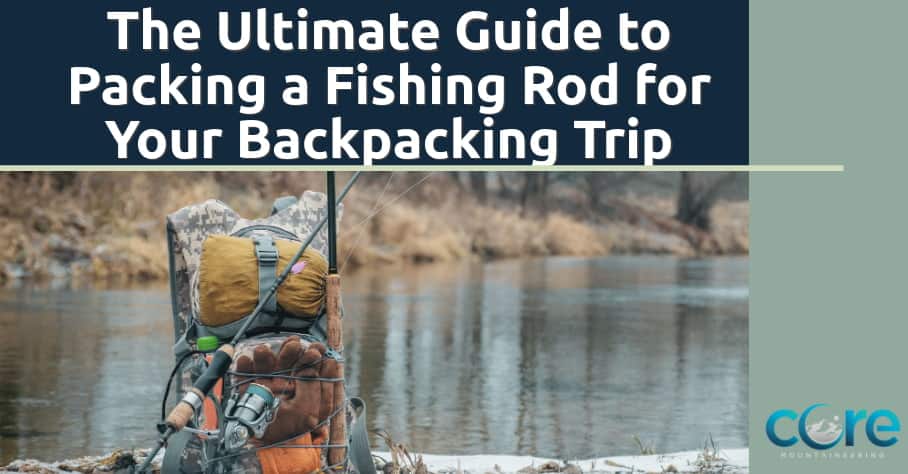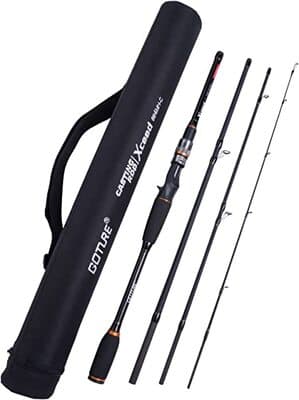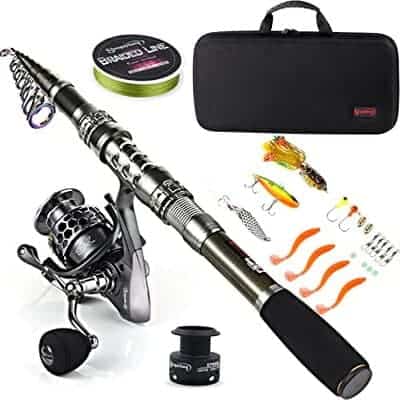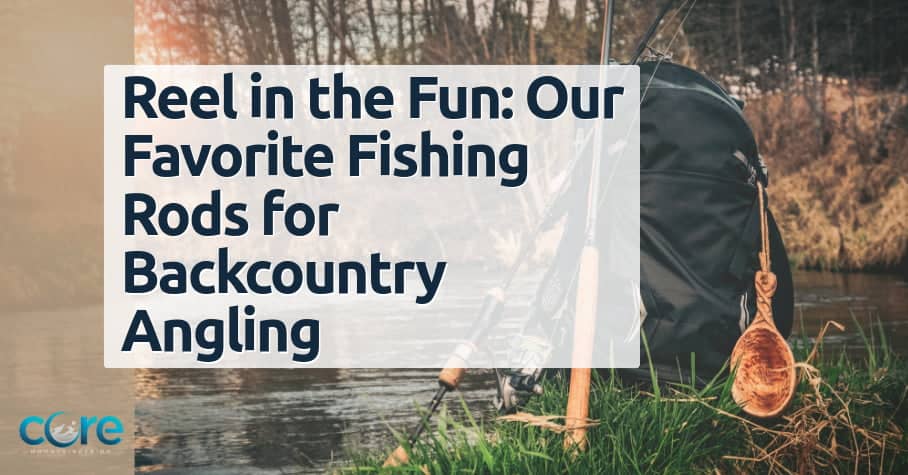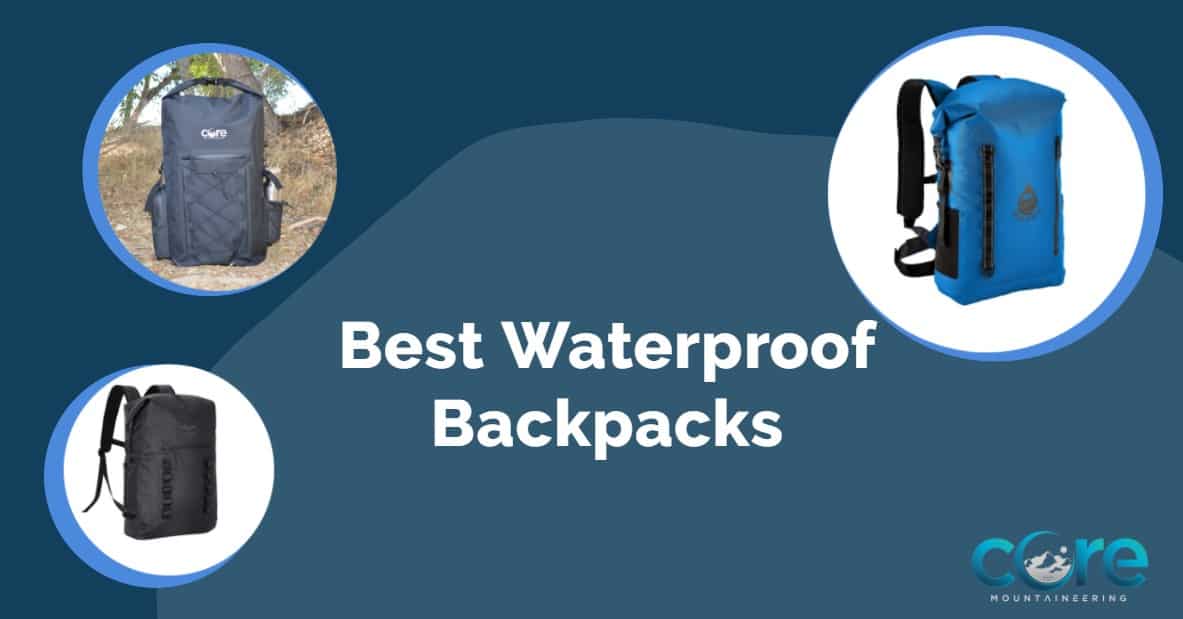Looking for the best way to pack a fishing rod for your next backpacking trip? Whether you’re an experienced angler or a hopeful beginner, fishing is the perfect addition to any hike.
If you’ve ever wandered through the wilderness and spotted a serene, untouched stream or pond, you might have regretted not packing a fishing rod. Well, don’t let that opportunity slip by again. Fishing can be the perfect complement to any backpacking trip, and with the right gear, it’s easy to bring along.
Luckily, there are plenty of compact and lightweight travel rods available to make transporting your fishing gear a breeze. From multi-piece and telescopic rods to folding pocket and pen rods, there’s a variety of options to choose from. And with the right packing methods and protective gear, you can ensure that your rod is secure and well-protected during your journey.
Join the ranks of backpacking anglers and experience the thrill of casting your line into the unknown. Who knows what kind of fish you might catch in those remote bodies of water? Don’t let your next adventure go without some unforgettable fishing memories.
Multi-piece Fishing Rods
A collapsible fishing rod breaks down into multiple sections. When the rod comes apart, you have 2-6 separate pieces of the rod, depending on the design. The ability to break the rod apart significantly reduces its storage length.
Putting the rod back together is easy. Each rod piece’s tip has a circular sleeve (known as a ferrule) which allows the next piece to slide into it. As each piece slides into the previous lower section, it’s then rotated to align the eyes.
You can find the current price of this fishing rod here.
Telescopic Fishing Rods
A telescopic fishing rod collapses down into the handle of the fishing rod when not in use. Unlike a multi-piece rod, which consists of independent sections, a telescopic rod remains a single unit even when it’s broken down.
Setting up a telescopic rod is very simple. You pull the tip of the rod out, and then each rod section extends from the base. Once each piece rises to its maximum height and the joints lock in place, you’re good to go.
Check to see if this fishing rod is still available here.
Foldable Pocket Fishing Rods
A foldable pocket fishing rod falls into the mini rod category. Even at full height, it’s nowhere near the same size as a traditional fishing rod.
These rods are less than a foot long when folded down, making them very easy to store in your backpack. They come with a reel built into the handle for more convenient fishing on the go. The pole is usually short and fixed, although there are some telescopic options out there.
You can find the current price of this Pen fishing rod here.
What is a Pen Fishing Rod?
Pen fishing rods are the smallest rods out there. As the name implies, they look like a pen and are no bigger than one when broken down. Like a telescopic rod, it extends from the base, but its full length is significantly shorter.
A tiny reel comes with the rod, but unlike the foldable pocket rod, it’s detachable.
Check out our article, Reel in the Fun: Our Favorite Fishing Rods for Backcountry Angling.
Multi-piece Fishing Rod Advantages
- Multi-piece rods have strength and sensitivity that are almost equal to one-piece rods, making them a good option for advanced anglers.
- Compared to telescopic rods, multi-piece rods have superior sensitivity.
- Multi-piece rods are more durable and long-lasting than telescopic rods, especially at budget prices.
- Multi-piece rods are a better choice for saltwater fishing due to the corrosive nature of saltwater and the need for longer rods.
- If you’re looking for a saltwater rod in the 10-15ft range, you’ll find a better selection of reliable multi-piece rods than telescopic ones.
Strength and Sensitivity
Out of all the travel rods, multi-piece rods are the most similar to your standard one-piece rod.
Their strength and sensitivity (ability to sense a bite) are nearly equal to a one-piece. Realistically, only advanced anglers will be able to notice any difference here.
Also, compared to telescopic rods, the sensitivity of a multi-piece rod is superior.
Durability and Longevity
Multi-piece rods are far more durable and long-lasting than telescopic rods.
This is, in part, thanks to the relatively simple design of multi-piece rods. It’s also because telescopic rods have more moving parts making them more likely to break.
Multi-piece rods are durable even at budget prices, but the same is not true for telescopic rods. Budget telescopic rods are, for the most part, unreliable pieces of junk. You can barely trust them to function out the box let alone after continuous use.
This is not the case with less expensive multi-piece rods. Even at a budget price point, they’re reliable and have decent longevity.
Saltwater Fishing
For those coastal campers out there who plan on saltwater fishing, multi-piece rods are the way to go.
Saltwater is one of the most corrosive elements on the planet. Sand gets EVERYWHERE. That means the moving parts of a telescopic rod are even more likely to break when saltwater fishing.
Also, consider that you need longer rods for certain types of saltwater fishing, such as surfcasting. So, if you’re looking for a saltwater rod in the 10-15ft range, you’ll find a better selection of reliable multi-piece rods than telescopic ones.
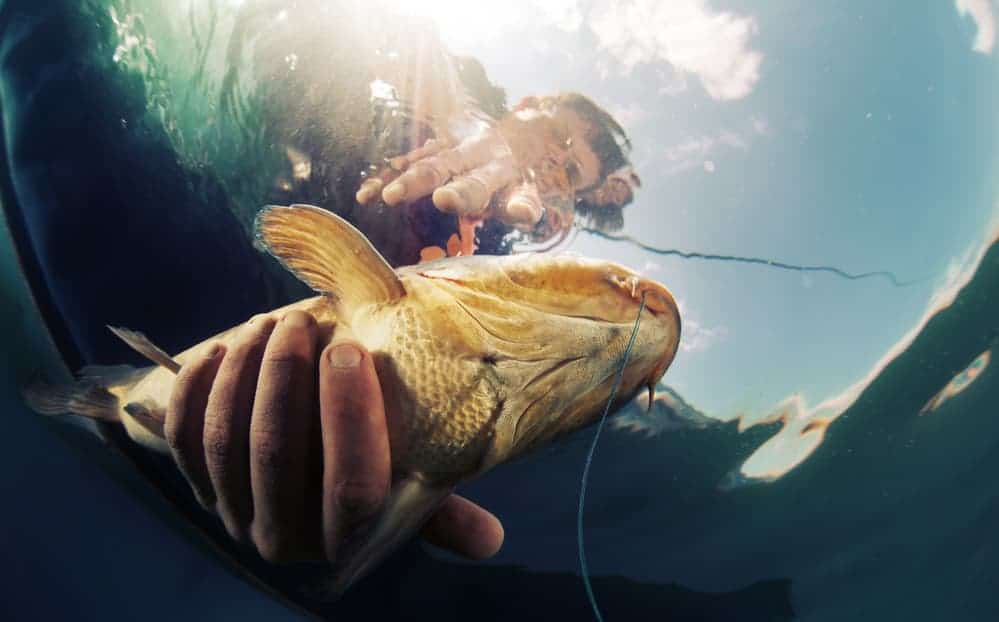
Multi-piece Fishing Rod Disadvantages
- Multi-piece rods are bulkier than every other travel rod, so you’ll need to account for extra space in your pack or use alternative methods to carry it.
- More pieces mean more potential for problems, such as misalignment of the eyes, which creates excess friction on the line and weakens it over time.
- There are no locking mechanisms used to secure the pieces together, which means you could end up tossing half your rod in the water during a cast if they become loose.
- Multi-piece rods have fewer moving parts than telescopic, but they still have more than standard one-piece rods, so reliability is somewhat sacrificed for portability.
- While multi-piece rods are more durable and long-lasting than telescopic rods, they still have the potential for detachable pieces to get lost or misplaced, which could be a minor inconvenience.
Bulkiest Travel Rod
Although multi-piece rods are more portable than standard one-piece rods, they’re bulkier than every other travel rod. Depending on how many pieces the rod breaks down to and the size of those pieces, you’ll need to account for this extra space.
You’ll be sacrificing room in your pack, or you’ll need to use alternative methods for carrying the rod. We’ll talk more about packing later in this post.
More Pieces=More Problems
Multi-piece rods have fewer moving parts than telescopic, but they still have more than your standard one-piece. This means what you gain in portability comes at the expense of some reliability.
Rotating Pieces
Each piece of the rod has the potential to rotate at the joint where it’s connected to the other rod pieces. When rotation occurs, it causes misalignment of the eyes–the more pieces in a rod, the more potential for rotation.
If rotation becomes a problem with your rod, it becomes a real pain to continuously fix.
It also will affect the reliability of your entire line. Inevitably you’ll end up casting when the eyes are not aligned, which creates excess friction on the line. Over time, this friction will weaken the line and increase the chance of it breaking.
There are few things more heartbreaking than losing a fish because of a broken line. Unless you are meticulous about the rod’s eyes’ alignment, you could be setting yourself up for a major letdown.
Detachable Pieces
When the pieces join together, there are no locking mechanisms used to secure them. It’s merely a tight fit that prevents the pieces from slipping. The problem is if you don’t fully push the pieces together, or they somehow become loose, you could end up tossing half your rod in the water during a cast.
Depending on the situation, this could mean a tangled line or lost rod pieces. At the very least, it means you spooked whatever fish are in the area.
A minor consideration with detachable pieces is also the ability to lose or misplace one. If you’re the type of backpacker who tends to lose gear, you might find yourself scratching your head, wondering where part of your rod went.
Telescopic Fishing Rod Advantages
- Portability and versatility: Telescopic rods strike a balance between portability and versatility. They collapse into a shorter length and thinner profile than multi-piece rods, making them more efficient for storage and transport.
- Strength and versatility: Telescopic rods are strong enough to handle most fishing situations and can catch the same size fish as multi-piece rods.
- Ease of setup and use: These rods are quick and easy to set up, increasing fishing frequency. The rod pieces won’t move once extended, reducing the risk of losing parts during casting.
- Lightweight: Telescopic rods are usually made of lightweight materials such as graphite, making them easy to carry and handle.
- Affordable: Compared to other types of fishing rods, telescopic rods are generally more affordable and accessible, making them a great option for beginners or budget-conscious anglers.
Portability and Versatility
A telescopic rod provides an efficient balance between portability and versatility.
For starters, it breaks down into a shorter length than multi-piece rods. It also collapses into itself. This makes the profile significantly thinner than a multi-piece when broken down. Both of these features save you pack space and increase your storage options.
This increased portability doesn’t come at the expense of strength and versatility. You can still catch all the same fish you could on a multi-piece rod for the most part. As we mentioned before, you’ll sacrifice some sensitivity, but that doesn’t mean it can’t handle the same size fish.
It may not be as portable as the folding pocket and pen rods, but it’s far more efficient at catching larger fish.
Ease of Setup and Use
Backpackers looking to fish without making a whole production out of the stop will appreciate how quick and easy these rods are to set up. There’s nothing to it. You just pull the rod sections out from the handle, and you’re ready to go.
By decreasing the time and effort it takes to set up your rod, you’ll undoubtedly increase the frequency you end up fishing.
It’s also worth noting that the pieces of a telescopic rod won’t move once extended. This means there’s no risk of a rod piece falling off during a cast. You also won’t have to worry about proper eye alignment like with multi-piece rods.
Telescopic Rod Disadvantages
- Less Durable: Telescopic rods have more potential points of failure due to their design, making them less durable than multi-piece rods.
- Budget Options are Junk: Cheap telescopic rods often have poor-quality parts that are more likely to fail, reducing their reliability and longevity.
- Less Sensitivity: Telescopic rods generally have less sensitivity than multi-piece and one-piece rods, making it harder to feel the first signs of a bite quickly.
- Risk of Jamming and Loosening: Telescopic rods are at risk of joints getting filled with dirt, sand, and other small material, causing jams, and over time, worn-out joints create loose and wobbly sections of the rod.
- Limited Length Options: Telescopic rods come in limited length options, and the longer they are, the more they tend to sag, which can affect the accuracy of the cast.
Less Durable
The sections of a telescopic rod slide in and out of each other without ever detaching making the rod one big moving part. This means there are more points of potential failure.
Telescopic rods are at risk for both jamming and loosening.
The joints (points where the rod pieces slide in and out of each other) can corrode or get filled with dirt, sand, and other small material, causing jams. Over time, joints will get worn out, creating loose and wobbly sections of the rod. When those loose joints rotate, you’ll be stuck with misaligned eyes and no ability to align them securely.
The end result is a less durable rod that likely won’t last as long as a multi-piece rod. That said, they’re still a more reliable option than pen and folding pocket rods.
Budget Options are Junk
All the problems mentioned above are even more likely when you buy a cheap telescopic rod.
As we mentioned, there are a lot of moving parts. When a company chooses to use the cheapest parts available to provide the lowest price, it’s no surprise that these parts will fail. It’s common to read reviews of budget rods with loose joints and misaligned eyes directly out of the box. Even if the rod does come fully functioning, something’s bound to go wrong even with minimal use.
Multi-piece rods at least provide an acceptable degree of reliability at the budget end. You’ll never find that peace of mind or longevity with budget telescopic rods. Budget buyer beware.
Less Sensitivity
Telescopic rods generally have less sensitivity than multi-piece and one-piece rods. A lot of this comes down to the rods being so thin. The ability to feel the first signs of a bite quickly is significant depending on the species of fish you’re after.
Casual anglers may not care or notice this difference. This could be a deal-breaker, however, if you prefer fishing with a more sensitive rod.
Folding Pocket Fishing Rod Advantages
- Folding pocket rods are compact and convenient, making them a great backup fishing option while hiking.
- They are shorter and lighter than most telescopic rods, adding minimal weight to your pack.
- They are also relatively inexpensive, costing around $25-40, making them an affordable option for those on a budget.
Compact and Convenient
The main reason to buy a folding pocket rod is for its size and convenience. They are also great as a backup fishing rod while hiking.
Even when it’s fully extended, it’s still shorter than most telescopic rods. It also weighs less. So you won’t add much to your pack weight. Plus, it’s ready to go in seconds and breaks down just as fast.
You never know when you’ll be hiking and come across a stream or pond with some fishing potential. The ability to throw a pocket rod in your pack ‘just in case’ without any weight or space burden makes them a convenient little piece of gear.
Cost
If you’re not looking to spend much money on your backpack fishing setup, these little rods won’t break the bank.
For around $25-40, they’re cheap enough to buy even if you’re not sure how much use you’ll get out of it. It also won’t hurt your wallet as much when it inevitably breaks.
Folding Pocket Fishing Rod Disadvantages
- The folding pocket rod is only suitable for small to medium-sized fish and not for catching trophy fish.
- It is less efficient than other fishing rods, with a limited casting range and a less robust reel.
- The folding pocket rod is not very durable and is prone to breaking, although its affordability makes it relatively easy to replace.
Limited Fish Size
Let’s be honest. You’re not going to catch a trophy fish with this rod. It’s only meant for small-medium sized fish. Even medium-sized is pushing it. Sure, you could hook into a bigger fish, but don’t expect to land it.
It’s far from the most efficient rod for catching fish. It can’t cast very far, and the built-in reel is not exactly heavy duty. That said, it can reel in significantly larger fish than pen rods.
Less Durable
Even at their highest price point, these rods aren’t professional quality fishing equipment. They’re prone to breaking, and you shouldn’t expect them to last forever.
But the price makes them relatively painless to replace. Plus, once you’re catching fish, it won’t take long to get your money’s worth out of it.
When it comes down to it, you’re paying for convenience, not durability.
Pen Fishing Rod Advantages
Smallest and Lightest
Pen rods are the smallest and lightest-weight rod option out there. They’re even smaller than the folding pocket rods and take up virtually zero space in your pack or pocket.
They only weigh a few ounces which makes them a favorite among featherweight backpackers. Like folding pocket rods, you can pack a pen rod on the off chance you come across an opportunity to fish.
Cheap
Priced somewhere between $15-30, they’re even cheaper than the pocket rods. They’re kind of a ‘why not?’ type of purchase. Even if you only use it a few times, it’s worth the expense. And when it breaks, it won’t hurt your wallet to replace or write off as a loss.
Pen Fishing Rod Disadvantages
Extremely Limited Fish Size
You might be able to get away with catching some medium-sized fish with the pocket rod, but don’t expect to with a pen rod. These rods will land mostly small fish like perch and sunnies. Anything larger will be somewhere between a severe struggle to impossible.
CoreM Tip: Experienced anglers advise not to even mess around with the reel that comes with these rods. Instead, only use the rod to cast the line and hook the fish. Once you’ve got the fish hooked, pull the line in by hand. You can’t cast far with them, so there’s not much line to pull in.
Use this method and upgrade to a stronger line, and you’ll have the ability to catch much larger fish.
The Least Durable
Pen rods are even less durable than pocket rods. The rods break very easily and typically require a superglue repair after limited use.
And you can forget about the reel that comes with these things. They’re useless and poorly constructed. Just count on pulling it in by hand from the get-go.
Protecting Your Fishing Rod
Before you decide how you’ll carry your rod while backpacking, you’ll want to consider how to protect your rod. Despite their ability to bend, fishing rods break easily, especially at the eyes and tip. So, additional protection is essential.
There are plenty of options that offer varying degrees of protection. Sleeves and socks are the lightest but least protective for the ultralight backpacker. On the other hand, hard plastic tubes and specialty rod cases offer extreme protection but at the expense of weight, size, and price.
Consider how vital the protection of your rod is to you, the additional weight you’re willing to carry, and your preferred carry method.
This brings us to…
Packing Your Fishing Rod
The packing method that works best for you depends on the style of rod and case you choose, your backpack, and the level of accessibility you want.
At the end of the day, packing techniques are a matter of personal preference. You’ll likely have to do a bit of experimenting, switching it up to see what method feels right to you.
Pack it in
Most travel fishing rods shouldn’t have any problem fitting in your backpack. However, if you choose to use bulkier protection for your rod, or your pack is already stretched to its interior carrying limit, this may not be an option.
Accessibility is also a factor to consider here. If you plan to fish while hiking and want to make the process as quick and painless as possible, it’s not ideal if you have to open up and search through your bag.
Strap it on
Strapping your rod to the exterior of your backpack provides excellent accessibility and frees up room in your pack.
Many backpacks come with the ability to strap on a tent or sleeping bag. You can use these to secure your fishing rod to the outside of your pack.
Using those straps for other gear? Not a problem. Use some rope or pick up a set of these inexpensive buckle straps and get creative with where you secure the rod to your backpack. They work exceptionally well when attached to securing loops and handles, and they are only a few bucks.
You can check to see if they are still aviable on Amazon here, buckle straps.
Hang it off
Hanging your rods from one of the securing loops or handles improves accessibility and conserves pack space. However, if it hangs loose, it’ll bounce around while you’re hiking. That’ll get pretty annoying after a while.
To make the hanging method happen, you’ll need a protective case with some kind of loop. You can then use a carabiner or piece of rope to secure the loop on the protective case to a securing loop, handle, or strap on your backpack.
Dedicated Fishing Backpack
If fishing is the primary reason you’re hiking and you have a bunch of fishing gear, a backpack designed for fishing could be your best bet.
These backpacks have sections specifically designed to hold your rods, reels, and various tackle. It makes the storage and organization of all your fishing gear about as efficient as it gets.
The downside to these backpacks is that they lack space for other types of gear. You may be able to get away with one on a day hike to a fishing hole. They aren’t, however, the best option for backpackers with diverse gear storage needs.
Wrapping Up
Fishing is not only fun–it’s a handy skill that provides food in places where food is hard to come by.
There’s no better way to get back to nature than to catch your own dinner while out in the wilderness. It’s a primitive satisfaction that adds to the experience many of us seek while backpacking.
Now that you have a better idea of which rod is right for you and the best ways to pack it get out there and start fishing!
Please take a look at our article on the best Best Waterproof Backpacks to keep all your gear dry!

